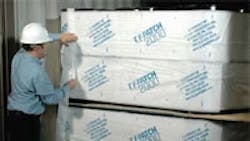About five years ago, Philadelphia-based Rohm and Haas Co.—an $8.9 billion specialty materials company—decided to take a serious look at blocking and bracing programs being used in its North American plants.
“At the time, everybody was sort of on their own to do it the way that they had done it for however long,” says Paul Little, logistics safety and trade compliance director. “We saw problems here and there. They would show up at the worst time in terms of getting product out to our regions—Asia in particular. Drums were damaged and couldn’t be sold.”
In conjunction with a contractor that does a lot of work in the transportation logistics area, the company underwent what Little characterizes as a “holistic” review of its load-securing practices. More than 20 plants and warehouses were surveyed. The goal was not necessarily to introduce new methods but better standardize practices that would be compliant with road, rail and ocean regulations and whatever combination of these modes was necessary.
Plant shipping personnel were employing all sorts of systems—including wooden rail gates, load bars and a product unfamiliar to Little at the time, known as Ty-Gard. Ty-Gard is a laminated, high-strength, pressure-sensitive acrylic adhesive restraint system developed about 25 years ago by Walnut Industries, Bensalem, Pa. (www.ty-gard.com).
How it Works
The Rohm and Haas plant based in Elma, Wash., was one of several that was a frequent user of Ty-Gard. It had been using the product since 1999.
Installation of Ty-Gard takes about 15 to 20 minutes. According to Grant Miller, Elma’s plant shipping manager, full loading requires about 45 minutes to an hour for two people working on a 40-foot sea container with 30-gallon drums of dry sodium borohydride, the main product shipped out of the facility. The chemical is sent in totes by truck to Mexico or in sea containers by rail to the East Coast. The resulting switch has saved the operation money through reduced cargo damage and insurance claims.
Lessons learned earlier in the field by various company plants would soon become known to the rest of the organization through Little’s “holistic” review. “We set about to really understand how to use all the different products properly, and that is when we first got a hold of the Ty-Gard folks,” explains Little. Trials and demonstrations of the system were held at a public warehouse in Bensalem and at Rohm and Haas’ Croyden, Pa., plant.
The end result was an instruction manual with about 25 individual diagrams showing different loading combinations with trucks and 20- and 40-foot sea containers. “All the detail was there, so that our loaders could understand what we were looking to do,” says Little.
The switchover to Ty-Gard was not accomplished without some initial skepticism, however. “These guys typically have a lot of pride in how they secure the load,” says Little. “They don’t want a release or spill on their watch. They looked at the Ty-Gard, thinking, ‘I am used to seeing 2x6s in there,’ so it took a little convincing that this adhesive material was in fact capable of securing 40,000-pound loads.”
One reason for the adoption of Ty-Gard by some Rohm and Haas plants was the implementation of new ISPM requi rement s requiring the use of treated wood for bracing in sea containers. Many countries will refuse cargo if the wooden dunnage doesn’t have the heat-treated symbol. The ergonomics and safety issues involved with sawing and hammering wood, along with the wood’s premium price, all combined to make the switch to Ty-Gard a natural at some locations for export shipments.
“If you happen to get caught in an inspection, it will go more quickly a lot of the time if the inspector looks in the back and sees no wood,” says Little.
One of the company’s key warehouses in Louisville, Ky., added Ty-Gard to i t s loadsecuring repertoire for shipping. Little has learned that the easiest way to introduce Ty-Gard is when a plant has a problem with its traditional methods. “Then, they are a little more open to change,” he says.
Little was impressed with the training and support Ty-Gard offered. “What is nice is that they will do a live-load demonstration. We have this product; it has to go in that sea container for a shipment on Thursday, and they will work with us, as opposed to playing around with a demonstration loading that we have to take back off the sea container. So, it’s quite efficient because we get the training, and we get the loading and securing all done at once,” he says.
“Your choices start to dwindle when you get into the export shipments, and that is where Ty- Gard fills an important need,” says Little. Ty-Gard meets the requirements of the International Maritime Dangerous Goods Code, the Association of American Railroads and the Bureau of Explosives for the Safe Transport of Hazardous Materials.
